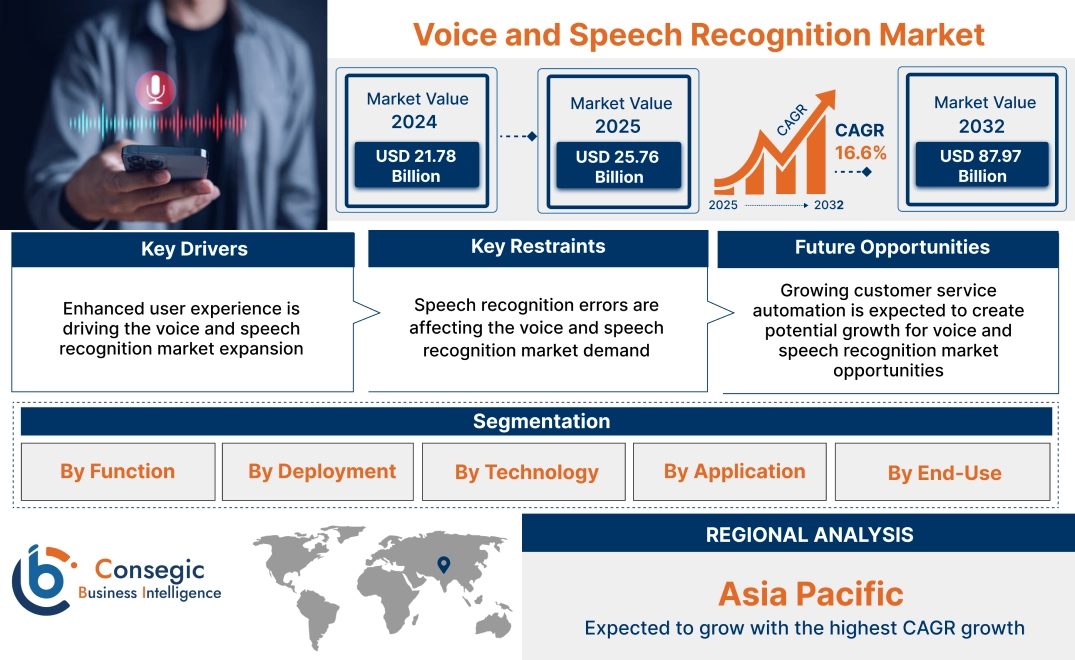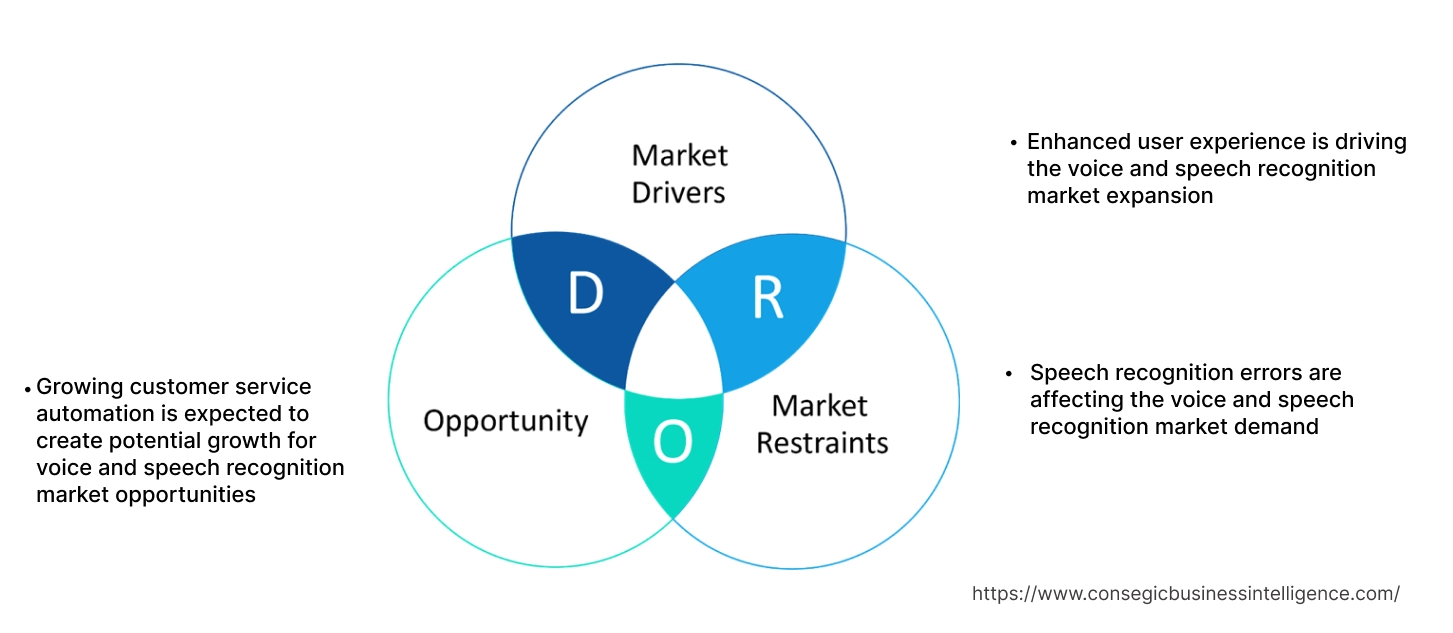- Summary
- Table Of Content
- Methodology
Voice and Speech Recognition Market Size:
Voice and Speech Recognition Market Size is estimated to reach over USD 87.97 Billion by 2032 from a value of USD 21.78 Billion in 2024 and is projected to grow by USD 25.76 Billion in 2025, growing at a CAGR of 16.6% from 2025 to 2032.
Voice and Speech Recognition Market Scope & Overview:
Voice and speech recognition technologies have become essential elements in the advancement of smart homes, virtual assistants, and hands-free operating systems. Voice recognition technology allows computers or systems to understand dictation and carry-out spoken instructions. By examining individual vocal attributes such as pitch, tone, and accent, it identifies unique patterns and transforms them into text. In contrast, speech recognition technology is centered on discerning words in spoken language and converting them into a format that a machine can read. Unlike voice recognition, which prioritizes the identity of the speaker, speech recognition focuses on comprehending spoken words and phrases, irrespective of the individual delivering them. This technology is applicable in tasks such as dictation, voice searching, voice dialing, and voice-activated command and control systems. With progress in artificial intelligence and machine learning, speech recognition software has become increasingly effective and precise, fueling its demand in various industries. As these technologies keep advancing and enhancing, they are anticipated to be instrumental in shaping the future of human-computer interaction.
Key Drivers:
Enhanced user experience is driving the voice and speech recognition market expansion
Enhanced user experience is central to advancements in the global voice and speech recognition market. With the progression of technology, users anticipate smooth, intuitive engagements with voice and speech recognition systems across an array of devices and platforms. One of the primary areas where user experience is improved is in recognition accuracy and speed. Contemporary systems are becoming increasingly proficient at interpreting natural language and various accents, which fosters more precise and effective interactions. Additionally, advancements in Natural Language Processing (NLP) capabilities have greatly improved user experience. These systems can now grasp context, intent, and sentiment, facilitating more conversational exchanges. This degree of comprehension permits more complex commands and inquiries, rendering voice and speech recognition software more intuitive and user centric.
Another factor enhancing user experience is the incorporation of voice and speech recognition into a broad spectrum of devices and applications. From smartphones and smart speakers to vehicles and home appliances, voice and speech recognition technology is becoming widespread. This integration allows users to engage with their devices in a more natural manner, eliminating the necessity for intricate interfaces and simplifying task completion. As this integration continues to grow, the overall user experience will keep enhancing, promoting further adoption of voice and speech technology.
- For instance, in September 2021, IBM Corporation introduced enhanced automation and AI features in IBM Watson Assistant to facilitate the development of exceptional customer experiences for businesses. This release includes a new collaboration with IntelePeer to evaluate a voice agent, which is a provider of Communications Platform-as-a-Service. The platform was designed to more effectively provide customers with relevant answers over the SMS, web, phone, or any other messaging platform.
Thus, according to the voice and speech recognition market analysis, the growing customer experience is driving the voice and speech recognition market size and trends.
Key Restraints:
Speech recognition errors are affecting the voice and speech recognition market demand
Speech recognition errors remain a significant challenge within the voice and speech systems. Factors such as background noise and environmental conditions can hinder precise speech recognition. In bustling settings such as offices, public transit, or even residences with several residents, surrounding noise can interfere with speech recognition technologies, causing mistakes in interpreting and processing spoken instructions. Furthermore, speech recognition mistakes can arise from homophones and words that sound alike, which can muddle the system and result in incorrect transcriptions or commands. Additionally, variations in speech caused by issues such as stuttering, lisping, or other speech difficulties can create obstacles for speech recognition systems, while leading to inaccuracies in transcription and comprehension. With the increasing demand for enhanced and dependable speech recognition systems, tackling these errors through sophisticated algorithms, machine learning, and data processing methods remains a crucial priority for industry stakeholders. These factors would have a further impact on the global market during the forecast period.
Future Opportunities :
Growing customer service automation is expected to create potential growth for voice and speech recognition market opportunities
The incorporation of voice and speech recognition technology into customer service operations is revolutionizing how businesses connect with their clientele. By automating common inquiries and tasks, organizations can greatly boost efficiency, cut down on operational expenses, and enhance customer satisfaction. Voice and speech recognition programs empower companies to implement virtual assistants and chatbots that can comprehend and reply to natural language questions. These virtual representatives can manage an extensive array of customer requests, including checking order status, offering product details, and addressing typical problems. Additionally, voice-driven self-service solutions allow customers to swiftly and conveniently resolve their questions, resulting in improved customer retention and loyalty rates.
Moreover, ongoing advancements in artificial intelligence and natural language processing are propelling the progress of customer service automation. Contemporary voice and speech solutions can assess customer sentiment, spot trends, and tailor interactions according to individual preferences. By leveraging these capabilities, businesses can provide more intuitive and engaging customer experiences, fostering better brand perception and a competitive edge in the marketplace.
- For instance, in April 2023, Verint launched Vetrint Intelligent Virtual Assistant platform, that enables professionals to design, deploy, and enhance virtual assistant quicker. The platform helps organizations gain confidence in their ability to provide high quality customer experience. Verint’s virtual assistant enables the swift and effective implementation of automation throughout an organization’s digital and voice platforms, providing uniform and tailored self-service interactions, while enhancing contact center performance.
Thus, based on the above analysis, customer service automation is expected to play a crucial role in shaping the future of the voice and speech recognition market opportunities and trends.
Voice and Speech Recognition Market Segmental Analysis :
By Function:
Based on function, the voice and speech recognition market is segmented into voice recognition and speech recognition.
Trends in the function:
- AI and deep learning are revolutionizing speech and voice recognition. They enable more accurate and natural language processing, leading to better user experiences.
- The popularity of virtual assistants like Alexa and Siri, along with the rise of smart homes, is fuelling the demand for voice and speech technologies.
- Voice recognition is increasingly used for biometric authentication in security systems and financial services, enhancing security and reducing fraud.
- Thus, factors such as growing adoption of virtual assistants and smart devices would further create the voice and speech recognition market demand and opportunities during the forecast period.
The speech recognition segment accounted for the largest revenue share in the year 2024 and it is expected to register the highest CAGR during the forecast period.
- Vehicles and smartphones are ideal platforms for speech recognition applications. The growing mobility of society demands that data and services always be accessible and in all locations.
- Utilizing both cloud and client-based speech recognition solutions can enhance the user experience while also offering companies substantial cost-saving opportunities.
- Additionally, this technology has been aiding healthcare professionals, including doctors and radiologists, in managing patient records due to advantages like shortened report turnaround times and improved record-keeping efficiency.
- Further, the combination of speech recognition with Virtual Reality (VR) is anticipated to drive increased market demand.
- For instance, in November 2024, iFLYTEK launched the auto-side SPARK large model for automotive cockpits. The cockpit possesses the ability to precisely grasp the needs and intentions of both drivers and passengers, delivering swift responses and addressing a range of issues with a blend of high EQ and IQ, which greatly enriches the overall driving experience.
- These factors and analysis are shaping the future of voice and speech recognition market during the forecast period.
By deployment:
Based on deployment, the market is segmented into on-premises and cloud.
Trends in deployment:
- The increasing adoption of cloud computing is driving the growth of cloud-based voice and speech solutions. Cloud platforms offer the necessary infrastructure, scalability, and AI capabilities to support these technologies.
- On-premises/embedded deployment is gaining traction due to growing concerns about data security and privacy. Keeping voice and speech data within local systems provides more control and reduces the risk of unauthorized access.
- These factors in the deployment segment would further drive the voice and speech recognition market trends during the forecast period.
The on-premises segment accounted for the largest revenue share in the year 2024.
- Organizations, particularly in sectors such as finance, healthcare, and government, frequently manage sensitive information. By opting for on-premises deployment, they can confine this data to their own networks, thereby diminishing the perceived threat of unauthorized access or data breaches.
- Certain sectors impose stringent regulatory mandates concerning data storage and processing. Implementing on-premises deployment can assist organizations in adhering to these compliance requirements, as it provides them with enhanced control over their data and systems.
- On-premises solutions typically offer increased customization and control over both software and hardware. This flexibility can be crucial for organizations with unique requirements or those aiming to adapt the system to align precisely with their workflows.
- The factors and developments, such as enhanced data security and improved compliance are driving the future of voice and speech recognition market growth.
The cloud segment is anticipated to register the fastest CAGR during the forecast period.
- Cloud platforms deliver limitless scalability, allowing all businesses to effortlessly modify their speech recognition capabilities in response to evolving needs, without the necessity of additional hardware or infrastructure investments.
- For small and medium-sized enterprises, cloud-based solutions can prove to be more economical. They usually come with reduced upfront expenses since organizations are not required to buy and manage their own hardware. Many cloud providers feature pay-as-you-go pricing structures, enabling businesses to pay solely for the resources they utilize.
- The access to advanced AI and machine learning technologies is another advantage of cloud platforms, which are crucial for creating precise and sophisticated voice and speech technology systems. Cloud providers dedicate substantial resources to research and development, continually enhancing their AI functionalities.
- For instance, in November 2022, North Hertfordshire (NHS) Trust and East introduced Enquire, a smart virtual assistant powered by IBM Watson Assistant on IBM Cloud. This project seeks to support the trust's HR team in handling inquiries from its 6,500 employees. The platform has been developed for the NHS Trust to alleviate the administrative load on HR personnel, enabling them to concentrate on more intricate and impactful responsibilities.
- These factors in the cloud deployment would further drive the voice and speech recognition market growth during the forecast period.
By Technology:
Based on technology, the market is segmented into AI-based and non-AI.
Trends in technology:
- Machine learning algorithms, especially deep learning architectures such as neural networks, play an essential role in developing precise and resilient speech recognition technologies. They allow systems to assimilate extensive datasets and enhance their capabilities progressively.
- Artificial intelligence and deep learning are transforming voice and speech technologies. They are fostering the development of systems that are more precise, sound more natural, and are sensitive to context.
- Ongoing advancements in AI and machine learning have resulted in remarkable enhancements in the accuracy and fluidity of speech recognition systems, rendering them increasingly dependable and user-friendly.
- These developments would further supplement the voice and speech recognition market trends during the forecast period.
The AI-based segment accounted for the largest revenue share in the year 2024 and it is expected to register the highest CAGR during the forecast period.
- Neural networks and deep learning models have transformed the landscape of voice recognition and speech recognition in AI. Their ability to identify intricate patterns and connections within extensive datasets has resulted in remarkable enhancements in both accuracy and performance.
- AI systems can adapt to the unique voices, accents, and preferences of individual users, offering tailored experiences. Furthermore, they can comprehend the context of conversations, allowing for more pertinent responses.
- The emergence of edge computing is facilitating increased AI processing directly on devices, which contributes to quicker response times, enhanced privacy, and the ability to function offline.
- For instance, in March 2023, Google AI has rolled out a new enhancement to its Universal Speech Model (USM), aligning with the 1,000 Languages Initiative. This universal speech model represents a machine learning algorithm crafted to understand and analyze spoken language across various languages and accents.
- These factors and analysis in the natural language processing technology segment would further drive the voice and speech recognition market size during the forecast period.
By Application:
Based on application, the market is segmented into customer service, voice search, smart home devices, diagnosis, pre-sales calls, voice biometrics for security, and legal chatbots.
Trends in application
- The rising popularity of smartphones, smart speakers, and various voice-activated devices is fuelling the need for voice recognition technologies.
- As users increasingly seek personalized and contextually relevant experiences, the advancement of more advanced speech recognition systems is being propelled forward.
- Thus, based on analysis, the aforementioned factors would further drive the voice and speech recognition market share during the forecast period.
The customer service segment accounted for the largest revenue share of 25.88% in the year 2024.
- AI-powered chatbots and virtual agents are evolving rapidly, now equipped to comprehend intricate inquiries, deliver tailored assistance, and address concerns with remarkable efficiency.
- Voice recognition technology is revolutionizing IVR systems, empowering customers to navigate options and retrieve information with greater speed and simplicity by using natural language.
- Through the application of sophisticated AI algorithms and natural language processing methods, automatic speech recognition systems can decode user inquiries, identify pertinent information, and customize responses according to individual preferences and past interactions. This degree of personalization allows organizations to cultivate more significant and relevant customer experiences, enhancing loyalty, satisfaction, and retention.
- Moreover, automatic speech recognition-driven personalization provides organizations with invaluable insights into customer behaviours, preferences, and sentiments, enabling them to fine-tune their marketing approaches, product offerings, and service delivery to align with the changing needs of their clientele.
- For instance, in August 2023, Meta has unveiled an AI model capable of translating speech and text into almost a hundred languages. This innovative model enhances efficiency and quality by minimizing delays and errors in the translation process.
- Thus, factors such as growing need enhanced personalization and customer experience are driving the global market share and trends during the forecast period.
The smart home devices segment is anticipated to register the fastest CAGR during the forecast period.
- Devices such as the Amazon Echo and Google Home have emerged as pivotal centers for voice-activated control within households. They facilitate music playback, alarm settings, lighting adjustments, inquiry responses, and the management of various smart home gadgets.
- Voice recognition technology is facilitating effortless operation of an array of smart home devices, including thermostats, lighting systems, locks, and appliances, all through spoken commands.
- Smart home technologies are increasingly merging with additional services like music streaming, e-commerce, and calendar organization, enhancing the overall interconnected experience.
- These factors and developments in the smart home devices segment would further drive the global market trends during the forecast period.
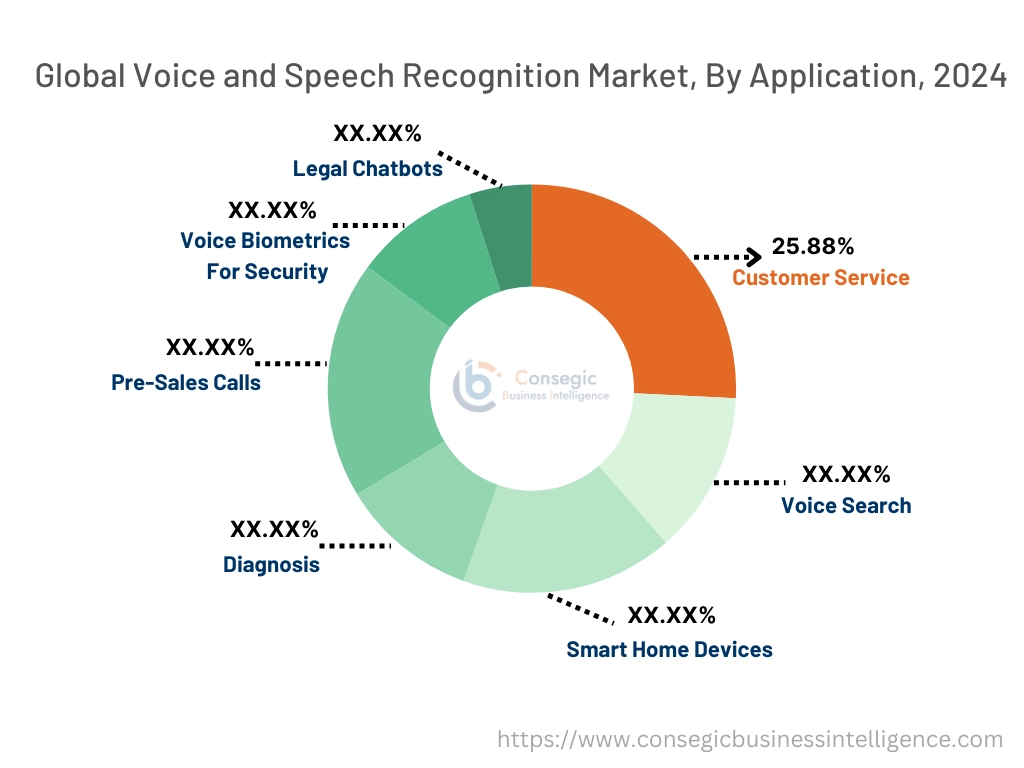
By End Use:
Based on the end use, the market is segmented into automotive, IT & telecom, BFSI, government & legal, retail & e-commerce, healthcare, education, travel & hospitality, media & entertainment, and others.
Trends in the end use:
- In the enterprise sector, voice assistant software is gaining traction to boost productivity and optimize workflow processes. Companies are utilizing this technology for various applications, including voice-activated searches, transcription services, virtual meeting assistants, and voice-enabled customer support. This innovation provides organizations with the chance to automate mundane tasks, lower operational expenses, and improve overall effectiveness.
- Voice commands are enabling consumers to manage smart speakers, smart TVs, thermostats, lights, and various connected devices, resulting in a more fluid and convenient user experience. Furthermore, the rise of smartphones equipped with integrated voice assistants is intensifying the need for voice assistant software within the consumer market.
- These developments in the industry would further drive the global market needs and trends during the forecast period.
The healthcare providers segment accounted for the largest revenue in the year 2024.
- They assist with a range of services including arranging and verifying appointments, sending appointment reminders, checking in with patients, and offering medical evaluations alongside physicians.
- The rising implementation of electronic health records (EHRs) and the necessity for smooth integration of healthcare systems have fuelled the need for Intelligent Virtual Assistants (IVAs) within the provider sector.
- Intelligent virtual assistants can connect with current EHR systems and obtaining patient data, allowing healthcare professionals to swiftly access pertinent information and make well-informed choices during patient meetings.
- For instance, in August 2023, Dolbey and Company, Inc. has announced the strategic partnership with SOAP Health, a leading pioneer in AI-enhanced medical practices. This collaboration merges Dolbey’s cutting-edge speech recognition technology, Fusion Narrate powered by nVoq, with SOAP Health’s proficiency in AI for medical interactions. The partnership aspires to revolutionize the dynamics between healthcare providers and patients, boosting productivity, revenue, early disease identification, diagnosis, and overall patient care outcomes.
- These trends and developments are anticipated to further drive the need for voice recognition systems in the global market during the forecast period.
The automotive segment is anticipated to register the fastest CAGR during the forecast period.
- Voice recognition empowers drivers to manage multiple vehicle operations, including navigation, entertainment, climate settings, and communication, all while keeping their hands on the wheel and their eyes focused on the road.
- Voice recognition technology is anticipated to be vital in autonomous vehicles, enabling passengers to engage with the car and oversee different functions via voice commands.
- These factors trends in the automotive industry would further drive the growth of the global market during the forecast period.
Regional Analysis:
The regions covered are North America, Europe, Asia Pacific, the Middle East and Africa, and Latin America.
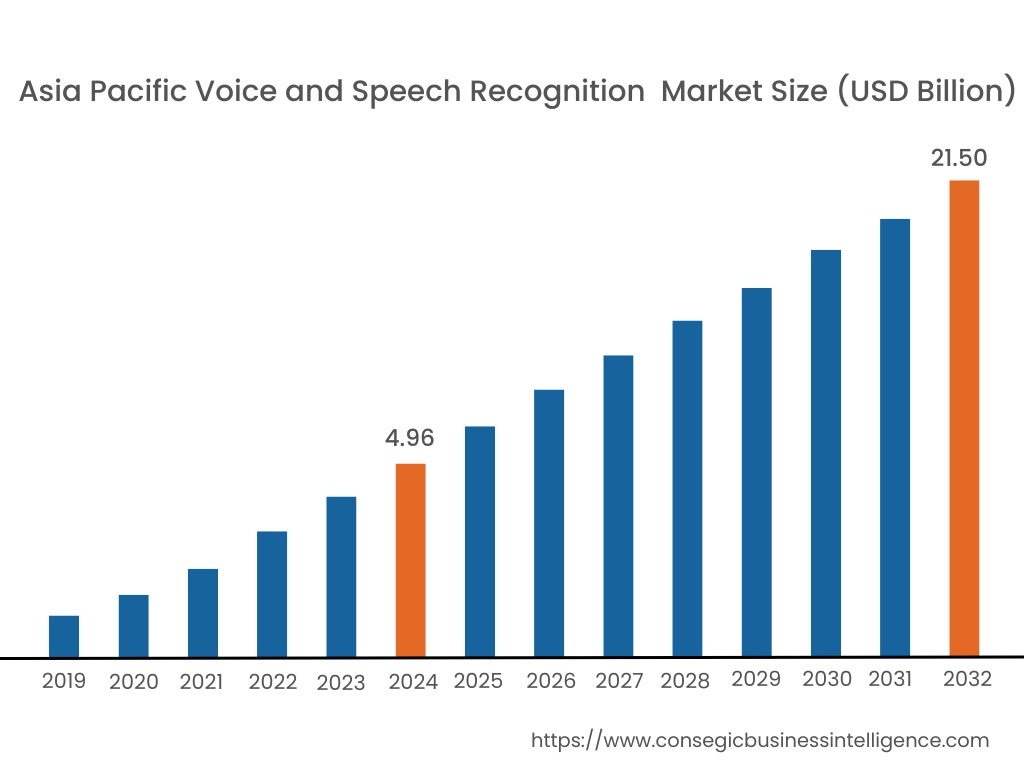
The global market has been classified by region into North America, Europe, Asia-Pacific, MEA, and Latin America.
Asia Pacific voice and speech recognition market expansion is estimated to reach over USD 21.50 billion by 2032 from a value of USD 4.96 billion in 2024 and is projected to grow by USD 5.90 billion in 2025. Out of this, the China market accounted for the maximum revenue split of 32.89%. As the number of patients and the breadth of healthcare services in the APAC region continue to grow, there is an escalating need for effective documentation solutions. This shift has led to an increased use of medical speech recognition software among radiologists. For instance, Apollo Hospitals in India has implemented Nuance's Dragon Medical software to enhance documentation efficiency throughout its facilities. Additionally, the integration of AI and NLP technologies into speech recognition software is progressing in the APAC region, resulting in heightened transcription accuracy and improved management of intricate medical terminology. Further, Samsung Medical Center in South Korea, which employs AI-driven speech recognition tools to boost the precision of clinical documentation. These sophisticated tools are facilitating more accurate and efficient management of patient records. Moreover, the swift progress in telemedicine, the rise of multilingual support, and a strong emphasis on data security and compliance are propelling the adoption of this software across the region. These factors would further drive the regional market during the forecast period.
- For instance, in August 2021, Amazon Transcribe offered group transcription in six additional dialects: Tahia, Afrikaans, Mandarin Chinese (Taiwan), Danish, New Zealand English, and South African English. These dialects are available in all AWS regions where Amazon Transcribe can be utilized.
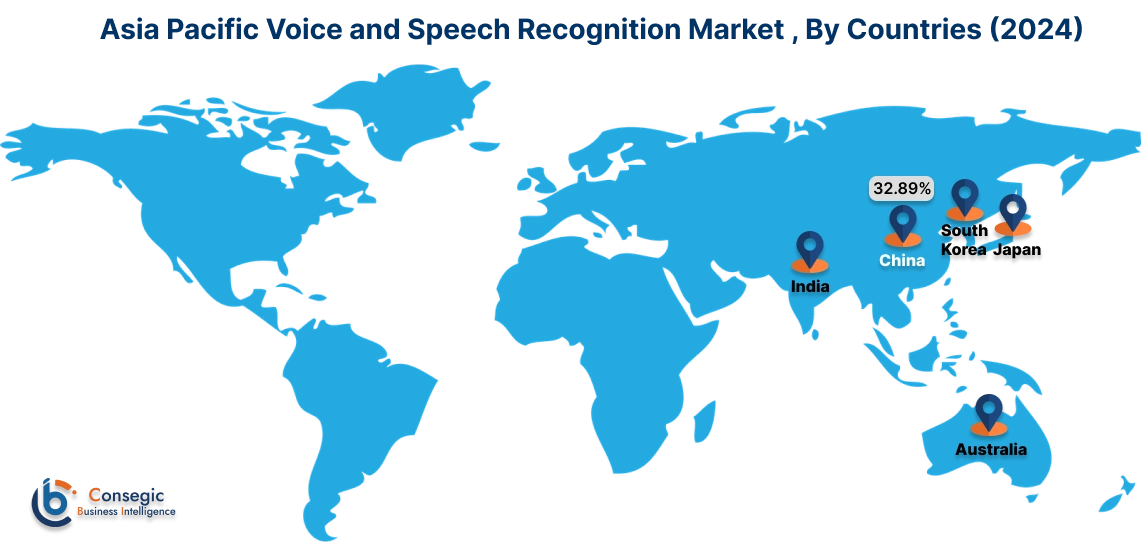
North America market is estimated to reach over USD 33.43 billion by 2032 from a value of USD 8.33 billion in 2024 and is projected to grow by USD 9.85 billion in 2025. The regional growth can be attributed to substantial technological progress and a swift rise in the use of smart devices. The need for voice-activated systems cuts across multiple sectors, including automotive, healthcare, and consumer electronics, fueling expansion within the regional market. The region is characterized by a thriving technological ecosystem, where prominent companies are making significant investments in artificial intelligence (AI) and machine learning advancements, which in turn propels the evolution of these technologies. Additionally, the existence of venture capital firms and robust governmental backing for research and development efforts consolidates North America's status as a frontrunner in these fields. These factors and developments would further drive the regional voice and speech recognition market share during the forecast period.
- For instance, in May 2023, Apple introduced a range of innovative cognitive accessibility features, such as Point and Speak in Magnifier, Personal Voice, and Live Speech, aimed at enhancing usability and accessibility for those with disabilities. Through active collaboration with disability advocacy groups, Apple underscores its commitment to keeping technology inclusive, ultimately making a significant impact on the lives of its users.
According to the voice and speech recognition industry, the European market has experienced significant growth driven by technological advancements, the growing embrace of smart devices, and an escalating need for effective human-machine communication. With both businesses and consumers placing a premium on convenience and efficiency, the regional market is poised to maintain its positive momentum, spurred by innovations in voice-enabled applications for various functions, including navigation and customer support. Additionally, the growing popularity of smartphones throughout Latin America significantly propels the voice and speech recognition market. These devices frequently come with integrated voice assistants and enable voice-driven applications. Additionally, in MEA region, businesses are progressively adopting speech recognition technologies in customer service to streamline support, boost efficiency, and elevate customer experience. This is particularly vital in a region characterized by a variety of languages and customer requirements. Additionally, voice recognition is being utilized in the healthcare sector for transcribing medical records, radiology reports, and patient notes, along with enabling hands-free control of medical devices. This technology can have a significant effect in regions where access to healthcare professionals is restricted. Thus, on the above voice and speech recognition market analysis, these factors would further drive the regional market during the forecast period.
Top Key Players and Market Share Insights:
The global voice and speech recognition market is highly competitive with major players providing speech and voice technology solutions to the national and international markets. Key players are adopting several strategies in research and development (R&D), product innovation, and end-user launches to hold a strong position in the market. Key players in the voice and speech recognition industry include-
- Apple (U.S.)
- Microsoft (U.S.)
- IBM (U.S.)
- Alphabet (U.S.)
- Amazon Web Services (U.S.)
- Baidu (China)
- iFlytek (China)
- SESTEK (Turkey)
- SemVox GmbH (Germany)
- Sensory, Inc. (U.S.)
Voice and Speech Recognition Market Report Insights :
| Report Attributes | Report Details |
| Study Timeline | 2018-2032 |
| Market Size in 2032 | UUSD 87.97 Billion |
| CAGR (2025-2032) | 16.6% |
| By Function |
|
| By Deployment |
|
| By Technology |
|
| By Application |
|
| By End-Use |
|
| By Region |
|
| Key Players |
|
| North America | U.S. Canada Mexico |
| Europe | U.K. Germany France Spain Italy Russia Benelux Rest of Europe |
| APAC | China South Korea Japan India Australia ASEAN Rest of Asia-Pacific |
| Middle East and Africa | GCC Turkey South Africa Rest of MEA |
| LATAM | Brazil Argentina Chile Rest of LATAM |
| Report Coverage |
|
Key Questions Answered in the Report
How big is the Voice and Speech Recognition market? +
Voice and Speech Recognition Market Size is estimated to reach over USD 87.97 Billion by 2032 from a value of USD 21.78 Billion in 2024 and is projected to grow by USD 25.76 Billion in 2025, growing at a CAGR of 16.6% from 2025 to 2032.
Which is the fastest-growing region in the Voice and Speech Recognition market? +
Asia-Pacific is the region experiencing the most rapid growth in the market. The growth of the regional market is propelled by elements such as advancing technology and heightened awareness of the advantages and affordability of devices. This movement is energized by a wide range of applications spanning multiple sectors, including smart home devices and voice assistance in banking, healthcare, and the automotive field.
What specific segmentation details are covered in the Voice and Speech Recognition report? +
The voice and speech recognition report includes specific segmentation details for function, deployment, technology, application, and end use, and region.
Who are the major players in the Voice and Speech Recognition market? +
The key participants in the market are Apple (U.S.), Microsoft (U.S.), IBM (U.S.), Alphabet (U.S.), Amazon Web Services (U.S.), Baidu (China), iFlytek (China), SESTEK (Turkey), SemVox GmbH (Germany), Sensory, Inc. (U.S.), and others.
